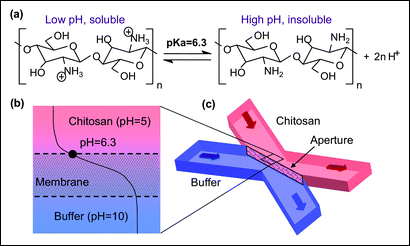 |

|
 |
(a) Polysaccharide chitosan with pH-responsive solubility; (b) a top view and (c) a 3D perspective view of the pH gradient across aperture openings between the buffer and chitosan flow streams. |
|
A paper produced by the research group of Professor Gary Rubloff (Materials Science and Engineering/Institute for Systems Research/Maryland NanoCenter/affiliate, Graduate Program in Bioengineering) has been selected for inclusion in Highlights in Chemical Technology (HCT). The magazine, produced by the Royal Society of Chemistry (RSC), combines interviews and reviews with select papers recently published in RSC's various peer-reviewed journals. HCT is designed to highlight the best examples of the industrial applications of the latest research in a variety of chemical sciences.
The Rubloff Group paper, "In situ generation of pH gradients in microfluidic devices for biofabrication of freestanding, semi-permeable chitosan membranes," originally published in Lab on a Chip, describes the group's advances in the use of chitosan, a naturally occurring bipolymer, as a biological membrane component of bioMEMS (biological microelectromechanical systems) devices and microfluidic systems used for microdialysis, filtration, gas-liquid exchange, and biochemical, bioanalytical, biosensing, and cellular studies. The group describes a fast, simple way of manufacturing the chitosan membranes. Their biofabrication technique also addresses problems associated with current fabrication methods that are harder to control and may result in cytotoxic conditions when used in cell culture environments.
Rubloff's co-authors are Xiaolong Luo (Ph.D. '08, currently a postdoctoral research associate), Dean Berlin (M.S. '09), Jordan Betz (graduate student, Fischell Department of Bioengineering), Gregory Payne (Professor, University of Maryland Biotechnology Institute), and William Bentley (Professor and Chair, Fischell Department of Bioengineering).
For More Information:
Visit the Highlights in Chemical Technology web site »
Read the article online »
November 20, 2009
|

